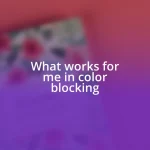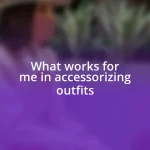Key takeaways:
- Vintage shopping offers uniqueness, sustainability, and a personal style statement, allowing shoppers to feel connected to the garments’ histories.
- Preparation, such as researching styles and carefully inspecting items, enhances the vintage shopping experience and increases the likelihood of finding quality pieces.
- Caring for vintage clothing involves gentle washing, proper storage, and maintaining suitable environmental conditions to preserve their quality and story.

Understanding vintage shopping benefits
One of the most significant benefits of vintage shopping is the uniqueness of each piece. I still remember the thrill of finding a one-of-a-kind 1960s cocktail dress at a local thrift store; I felt like I had uncovered a hidden treasure. Have you ever experienced that rush of excitement when you discover an item that feels like it was made just for you?
Not only do vintage items often come with a rich history, but they also embrace sustainability. When I choose vintage, I’m not just making a style statement; I’m making a conscious choice to reduce waste. It gives me a sense of fulfillment, knowing that I’m giving a second life to beautiful garments instead of supporting fast fashion. Isn’t it rewarding to contribute to a more sustainable future while elevating your wardrobe?
Additionally, vintage shopping can be a wonderful way to express your personal style. I’ve often walked into a bustling vintage market and walked out with pieces that ignite conversations. Each item has its own story, and when I wear them, I feel like I’m showcasing a part of that narrative. Don’t you think it’s more fun to wear something that tells a story rather than blending into the crowd with mass-produced fashion?

Essential tips for vintage shopping
When diving into the world of vintage shopping, preparation is key. I once walked into a thrift store without any idea of what I wanted, and after hours of aimless searching, I left empty-handed and disappointed. Now, I always carry a list of specific items I’m on the lookout for—whether it’s a retro blazer or a unique accessory—and it makes the process so much more enjoyable.
Here are some essential tips to enhance your vintage shopping experience:
- Research beforehand: Familiarize yourself with different styles and eras. Knowing what you like can save time and bring focus.
- Inspect items carefully: Look for wear, stains, or damage, especially in secondhand clothing. It’s a letdown to get home and discover a flaw that could have been avoided.
- Be open-minded: Sometimes, a piece may need a little TLC or creative alterations. Don’t shy away from items that have potential!
- Check fit and size: Vintage sizing can differ from modern sizes. Try things on or check measurements against your own before buying.
- Visit multiple stores: Each vintage shop has its own vibe and selection. Exploring different places increases your chances of finding that special gem.
With this approach, I’ve found some of my favorite pieces, like an exquisite 70s maxi dress that I initially hesitated to buy. After some thought, I decided to take it home, and I constantly receive compliments whenever I wear it!

Identifying quality vintage items
Identifying quality vintage items often hinges on familiarizing yourself with materials and craftsmanship. I remember the first time I felt the weight of a well-made wool coat from the 1940s; it just felt different, more substantial than anything new. Always pay attention to the fabric—natural fibers like wool, silk, and cotton usually indicate higher quality. They not only age better but also have a timeless quality that’s hard to replicate in modern synthetics.
Another crucial aspect is the stitching and construction. If you inspect the inside of an item, look for tight stitches and strong seams; these details can tell you a lot about its durability. One afternoon, while sifting through a rack, I came across a 1950s dress with hand-stitched hems. I felt an instant connection to the craftsmanship and care put into its creation; that dress became a staple in my wardrobe because of its exceptional quality, proving that it’s worth taking the time to look closely.
Lastly, consider the style and condition of a piece before any purchase. I’ve often been drawn to items that are slightly worn as they tell a story, but I’ve learned to assess their potential for wear. Once, I found a gorgeous pair of vintage leather boots, scuffed but with a rich patina. With just a little polishing and care, they became my go-to footwear, perfectly aligning with both my style and the vibrant history they carry. Holding onto this mindset has transformed my vintage shopping experience.
| Quality Indicators | What to Look For |
|---|---|
| Fabric | Natural fibers like wool, silk, and cotton |
| Construction | Tight stitches and strong seams |
| Style | Assess overall condition and wearability |

Best places to find vintage
Exploring local flea markets is one of my favorite ways to find hidden vintage treasures. There’s something exhilarating about sifting through countless stalls, with each corner potentially housing a unique piece of history. I recall the thrill of stumbling upon a box of vintage jewelry at a market; one sparkling brooch instantly caught my eye, evoking a glamorous era that I just had to bring home.
Thrift stores, surprisingly, can be a goldmine when it comes to vintage finds. On a whim, I decided to stop by a small, unassuming shop one rainy afternoon. As I flipped through the racks, I wasn’t prepared for the joy of discovering an authentic 1960s leather jacket tucked away and looking for a new owner. That moment made me realize that sometimes the most unremarkable places hold the most extraordinary surprises.
Don’t overlook estate sales either; they often offer an intimate glimpse into someone’s life and style. Each item carries a story, and as I rummaged through an old lumberjack’s belongings at one sale, I found a beautifully patterned flannel shirt. It felt like a connection to a past life, making it not just a clothing item but a cherished keepsake. Have you ever felt a spark from a previously loved item? It’s a sensation that can lead to unforgettable pieces in your wardrobe.
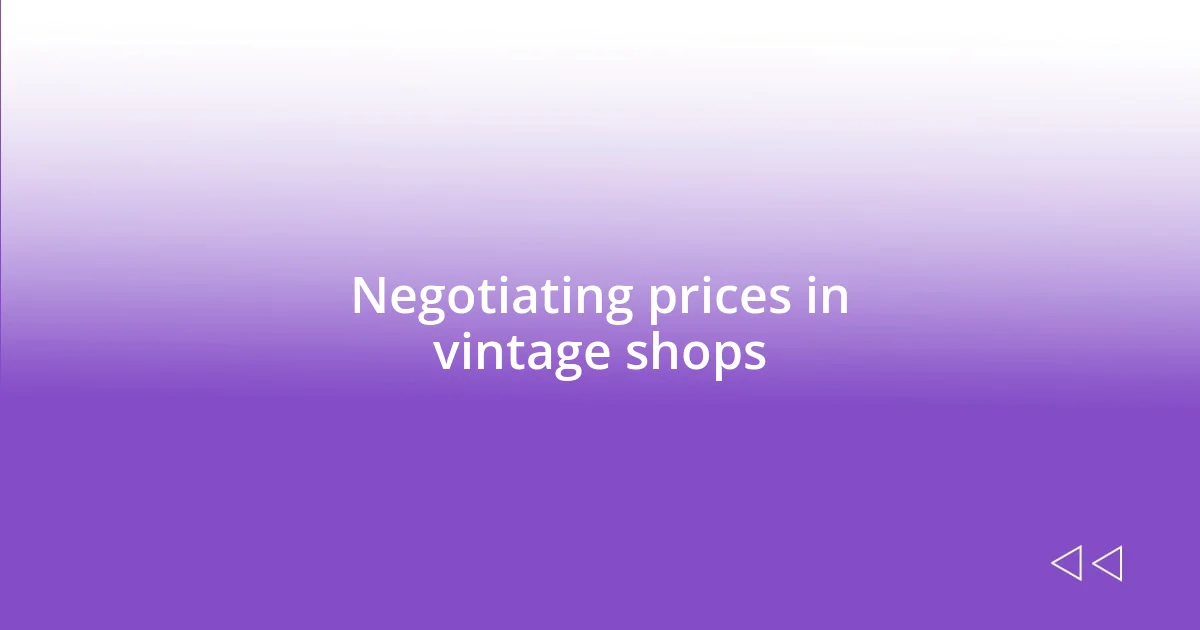
Negotiating prices in vintage shops
I’ve noticed that negotiating prices in vintage shops can be an effective way to score a great deal. I remember walking into a small vintage boutique, and spotting a stunning 1970s maxi dress. It was priced higher than I anticipated, so I mustered the courage to ask if there was any wiggle room. The shop owner smiled and knocked down the price a bit, reminding me that many vintage items have stories but also price flexibility. Have you ever felt a rush from making a successful deal? It can really enhance the shopping experience.
When it comes to negotiating, I find that timing matters. Visiting during less busy hours often gives you a better chance to chat with shop owners. Once, I strolled into a quaint shop during a weekday morning. The owner shared insights about the history of the items, and it naturally led to a discussion about the prices. We struck a deal on a nostalgic 90s bomber jacket, and I walked away feeling both satisfied and thrilled. Isn’t it funny how a little bit of conversation can turn a simple transaction into a memorable experience?
It helps to do your research before you approach a price negotiation. Knowing what similar items sell for online can give you the confidence to discuss price adjustments. I recall finding a unique pair of vintage earrings that I instantly fell in love with. A quick search revealed they were priced higher than their average market value; when I brought that up, the seller was surprisingly receptive and offered a discount. It’s all about being polite and informed. After all, vintage shopping should feel like a treasure hunt, where both the buyer and seller can leave happy.
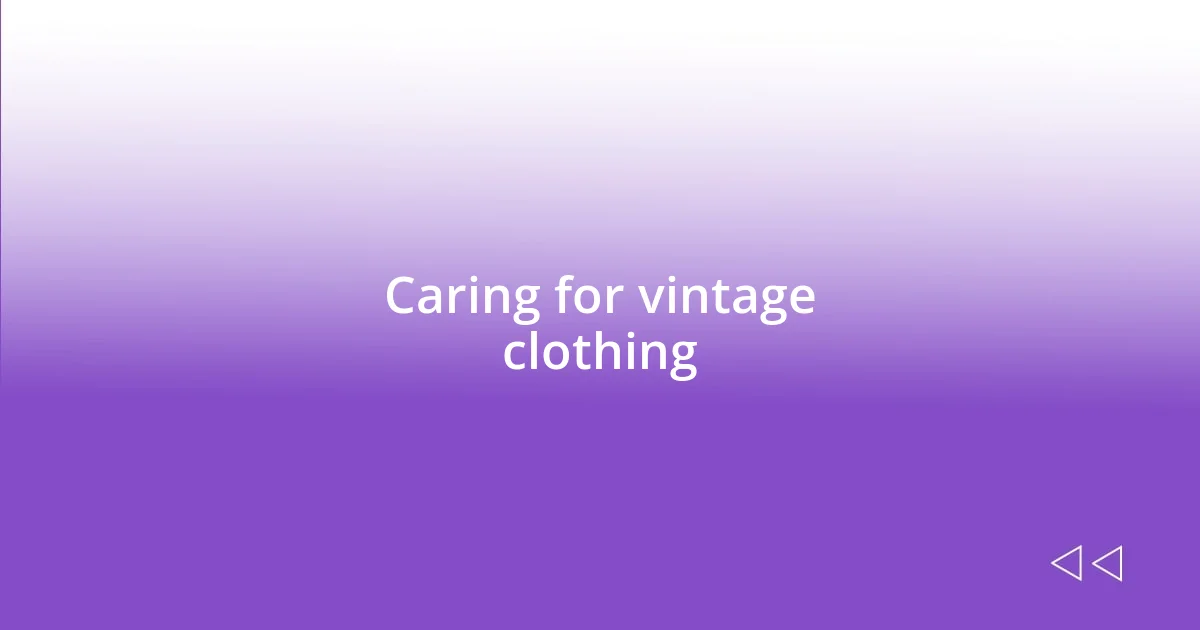
Caring for vintage clothing
Caring for vintage clothing is a bit like nurturing a delicate friendship; you want to show it the love it deserves while being mindful of its history. For instance, I always wash my vintage finds by hand, using a gentle detergent. I remember the first time I soaked a fragile lace dress—each splotch of color seemed to come alive in the water, and I felt a thrill knowing I was preserving a piece of history.
When it comes to storage, I never hang my vintage pieces on regular hangers. Instead, I invest in padded hangers that treat the fabric with care. Once, I placed a stunning 1940s silk blouse in my closet, and by using a padded hanger, it retained its shape beautifully. Isn’t it satisfying to keep those soft lines intact so that they’re ready to shine whenever you pull them out?
I also prioritize weather conditions, ensuring that my closet is cool and dry. I learned this the hard way after a fantastic vintage wool coat started to develop some unwanted mustiness. Since then, I keep little sachets of cedar in my storage to keep pesky odors—or moths—at bay. Doesn’t it feel rewarding to safeguard not just a garment but a story woven into each fiber?
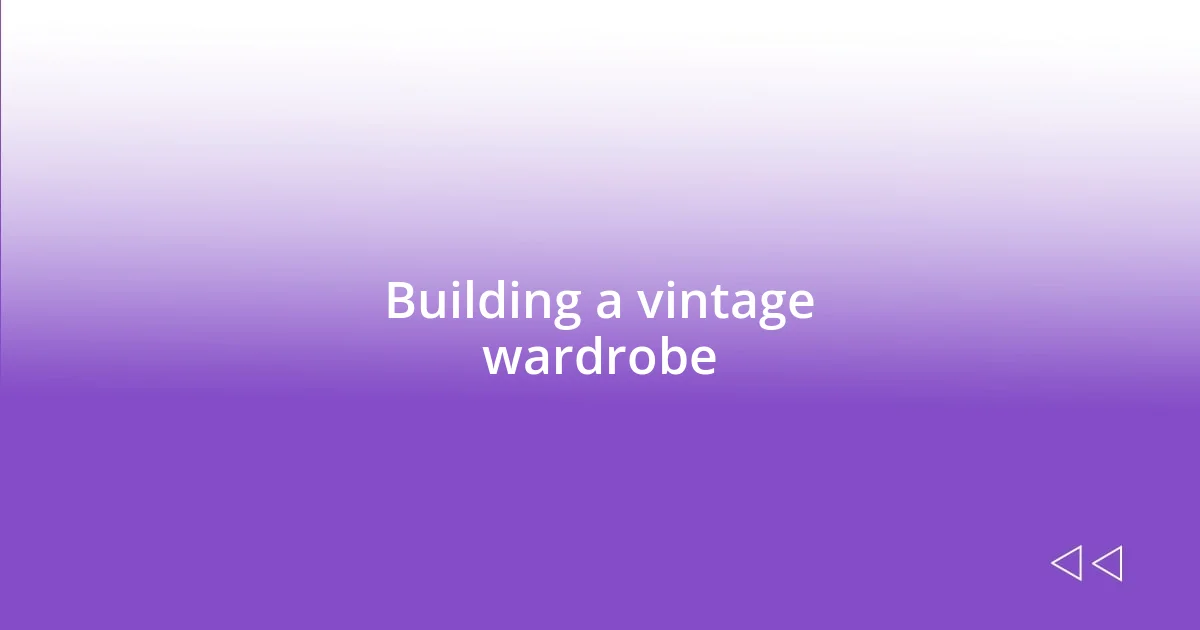
Building a vintage wardrobe
Building a vintage wardrobe is a journey that combines passion with practicality. Each piece tells a story, and I can’t help but feel a sense of adventure every time I add a new item. For instance, I remember the thrill of finding a retro 80s blazer at a local thrift shop. The vibrant color and oversized fit spoke to me, reminding me of the playful fashion of that era. Don’t you find it exhilarating when an item feels like it was just waiting for you to discover it?
As I’ve developed my vintage wardrobe, I’ve learned to focus on versatility. A well-curated vintage collection allows for endless outfit possibilities. I once stumbled upon a classic denim skirt that I quickly realized could be dressed up with a vintage blouse or down with a graphic tee. It’s like having a time machine in my closet, enabling me to express different facets of my style. How incredible is it to know that one piece can transform an outfit entirely?
I also find that keeping a clear theme helps when building my vintage collection. Whether it’s a focus on specific decades or particular styles—like bohemian or tailored chic—each direction brings its own kind of joy. When I decided to concentrate on 70s earth tones, I found myself enamored with the rich hues and playful patterns. It’s interesting how defining a theme not only streamlines shopping but also deepens the appreciation for each piece. Have you ever experienced that connection between your wardrobe and your personal style journey?

